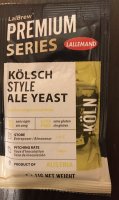bstacy1974
Well-Known Member
Well, I guess I stirred the pot asking a simple question. Please don't take offense to this statement. We're all passionate about our homebrew and I really appreciate all the feedback.
Yes, it's true that it's not a true kolsch but I'm not entering this beer into competition, so it doesn't matter all that much. I take the position to classify my beers as they drink. So, if it drinks or taste more like a blonde after packaging, I'll call it a blonde.
Thanks for the suggestions for liquid yeast but I don't have access to liquid yeast locally. I'm limited to dry yeast. I probably should have said that up front.
I'm pretty sure others have suggested warm fermented 34/70 as a dry yeast alternative for a Kolsch. This was before Lallemand came out with a dry Kolsch yeast. Again, can't get it locally yet, so I was going with what I had in my inventory.
With that said, I was able to pick up some K-97. What's everyone's experience with this strain?
Yes, it's true that it's not a true kolsch but I'm not entering this beer into competition, so it doesn't matter all that much. I take the position to classify my beers as they drink. So, if it drinks or taste more like a blonde after packaging, I'll call it a blonde.
Thanks for the suggestions for liquid yeast but I don't have access to liquid yeast locally. I'm limited to dry yeast. I probably should have said that up front.
I'm pretty sure others have suggested warm fermented 34/70 as a dry yeast alternative for a Kolsch. This was before Lallemand came out with a dry Kolsch yeast. Again, can't get it locally yet, so I was going with what I had in my inventory.
With that said, I was able to pick up some K-97. What's everyone's experience with this strain?






























![Craft A Brew - Safale S-04 Dry Yeast - Fermentis - English Ale Dry Yeast - For English and American Ales and Hard Apple Ciders - Ingredients for Home Brewing - Beer Making Supplies - [1 Pack]](https://m.media-amazon.com/images/I/41fVGNh6JfL._SL500_.jpg)


























